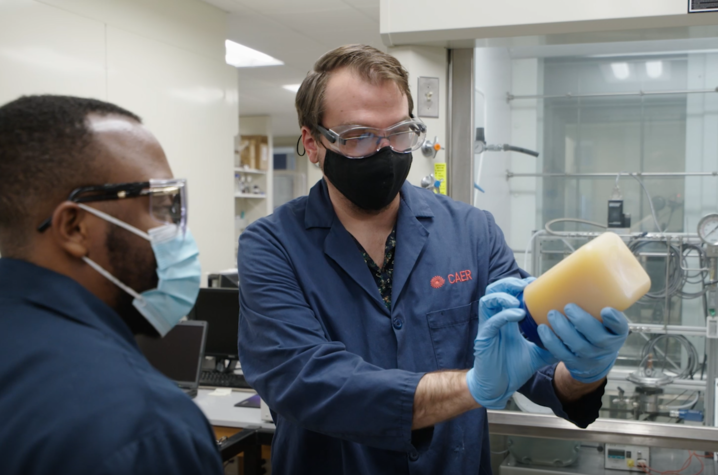Novel Funding Model Provides CAER Researchers Support to Produce Sustainable Aviation Fuel
Video produced by UK Center for Applied Energy Research. To view captions for this video, push play and click on the CC icon in the bottom right hand corner of the screen. If using a mobile device, click on the "thought bubble" in the same area.
LEXINGTON, Ky. (March 21, 2022) — Funding early-stage, proof-of-concept research is often a challenge for university researchers. Traditionally, governmental funding agencies have chosen to invest in basic science and in projects that are more advanced in their technological development.
Until now.
Biofuels researchers at the University of Kentucky Center for Applied Energy Research (CAER) recently received funding from OUR&D, a unique grassroots not-for-profit organization based in Denver, Colorado, that is seeking to supplement the current research and development funding landscape.
Watch this video to learn more about this project: https://youtu.be/PRPHkFYmGYA.
Founded by a group of clean energy scientists and experts, OUR&D was designed to “fill the gap referred to as the ‘valley of death’ that sits between good ideas and traditional funding sources.”
“OUR&D is working to fund as many ideas as possible to make sure that potentially world-changing innovations past the proof-of-concept stage,” said Brent Nelson, science director and board member of OUR&D. “It can take years of research to bring a new technology to market. It is our mission to fund those promising ideas now.”
OUR&D provided $50,000 funding for CAER’s next-generation sustainable aviation fuels research. As part of the project, CAER will be focused on doing something the center has been long known for — giving new life to industrial waste and byproducts. In this case, in addition to valorizing waste fats, oils and greases, researchers will also be upgrading rosin, a byproduct from the timber industry.
“Rosin is a pine chemical produced by the timber industry. If you've ever played or seen someone play a stringed instrument that uses a bow, you might have seen them rosin their bow. In this project we will convert the same material into sustainable aviation fuel,” said Robert Pace, Ph.D., an associate research scientist at CAER.
Notably, the CAER biofuels team specializes in transforming materials into what are commonly referred to as “drop-in fuels” — fuels that are chemically indistinguishable from fossil-derived products that are already in the marketplace.
“The goal is to develop something that you can drop into a plane right now and use it without modifying the plane in any way,” said Pace. “It would be impossible to rebuild every airplane on the market. Our approach is to bring innovation to the fuel itself and develop an alternative product that is ready to use.”
As pleased as Eduardo Santillan-Jimenez, Ph.D., program manager at CAER, was to be selected to receive this funding, he was more excited about what this type of proof-of-concept funding can mean to university research. He is hopeful that similar funding mechanisms like this from OUR&D will create more opportunities to fund promising new ideas that simply need a jumpstart.
“I really appreciate the opportunity we were given,” said Santillan-Jimenez. “It’s an honor and a privilege. The relationship that we have with OUR&D as a funding agency has already proven to be a most pleasant and productive one.”
This research is still ongoing; however, UK CAER researchers have already demonstrated that rosin and distilled tall oil can be upgraded over inexpensive Ni-based catalysts into the type of hydrocarbons constituting jet fuel. Currently, efforts are underway to identify the reaction conditions affording the best yield of sustainable aviation fuel (SAF). These reaction conditions will be used in experiments designed to study how catalyst activity, selectivity, and stability change over time as well as catalyst recyclability. These experiments will also afford the quantities of SAF needed for more thorough analysis and evaluation.
About OUR&D
OUR&D is a unique grassroots funding source for clean energy research. Founded by a group of clean energy scientists and experts, the 501(c )(3) was designed to fill the gap referred to as the “valley of death” that sits between good ideas and traditional funding sources. OUR&D works to fund as many ideas as possible to make sure that potentially world-changing innovations get far enough along to qualify for either government, academic, or industry funding. It can take years of research to bring a new technology to market, making it essential to fund promising ideas now. OUR&D empowers concerned citizens from all walks of life to participate first-hand in the development of clean energy technologies that are necessary to avert climate catastrophe. For more information visit www.our-and-d.org.

As the state’s flagship, land-grant institution, the University of Kentucky exists to advance the Commonwealth. We do that by preparing the next generation of leaders — placing students at the heart of everything we do — and transforming the lives of Kentuckians through education, research and creative work, service and health care. We pride ourselves on being a catalyst for breakthroughs and a force for healing, a place where ingenuity unfolds. It's all made possible by our people — visionaries, disruptors and pioneers — who make up 200 academic programs, a $476.5 million research and development enterprise and a world-class medical center, all on one campus.




